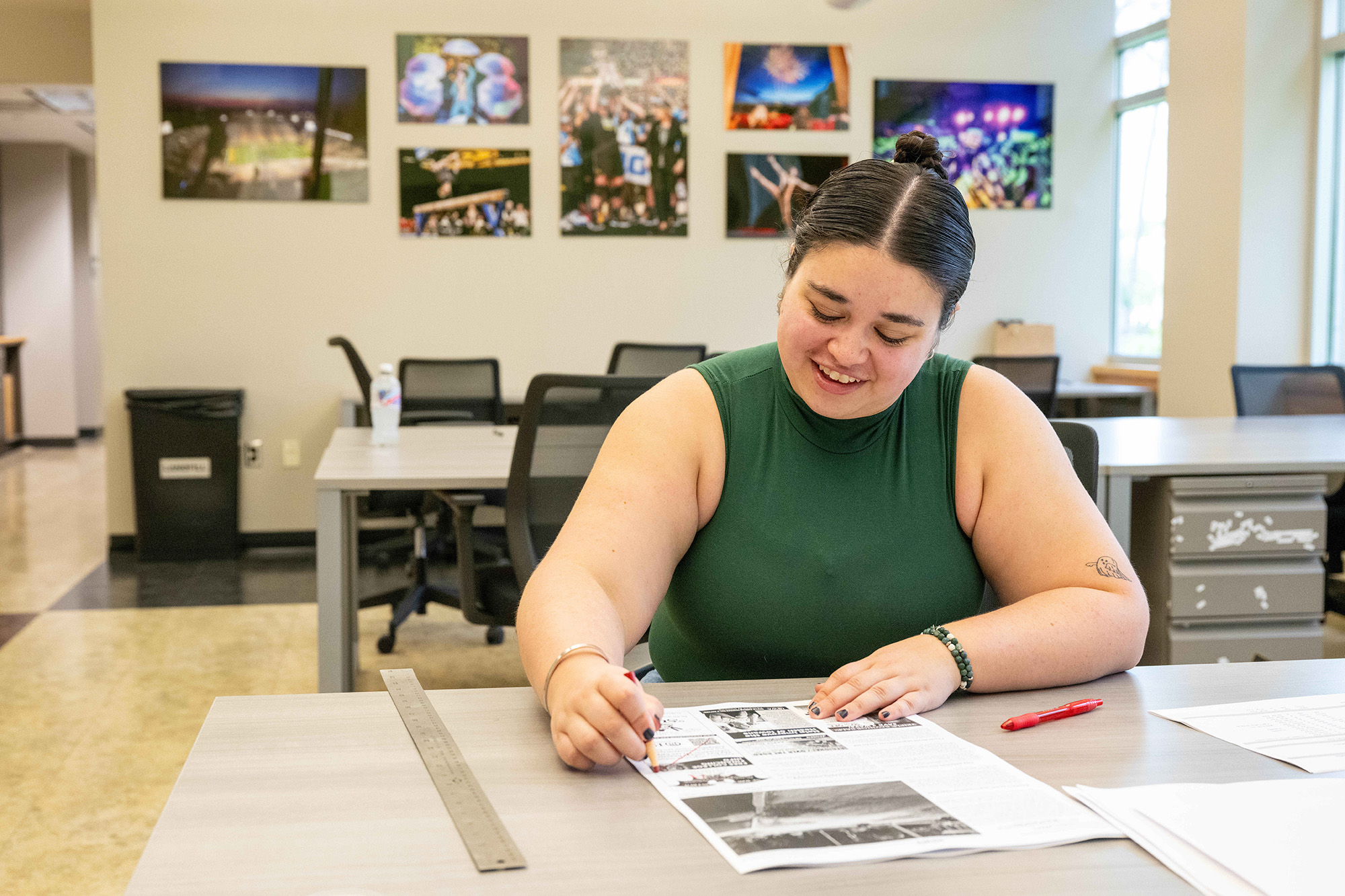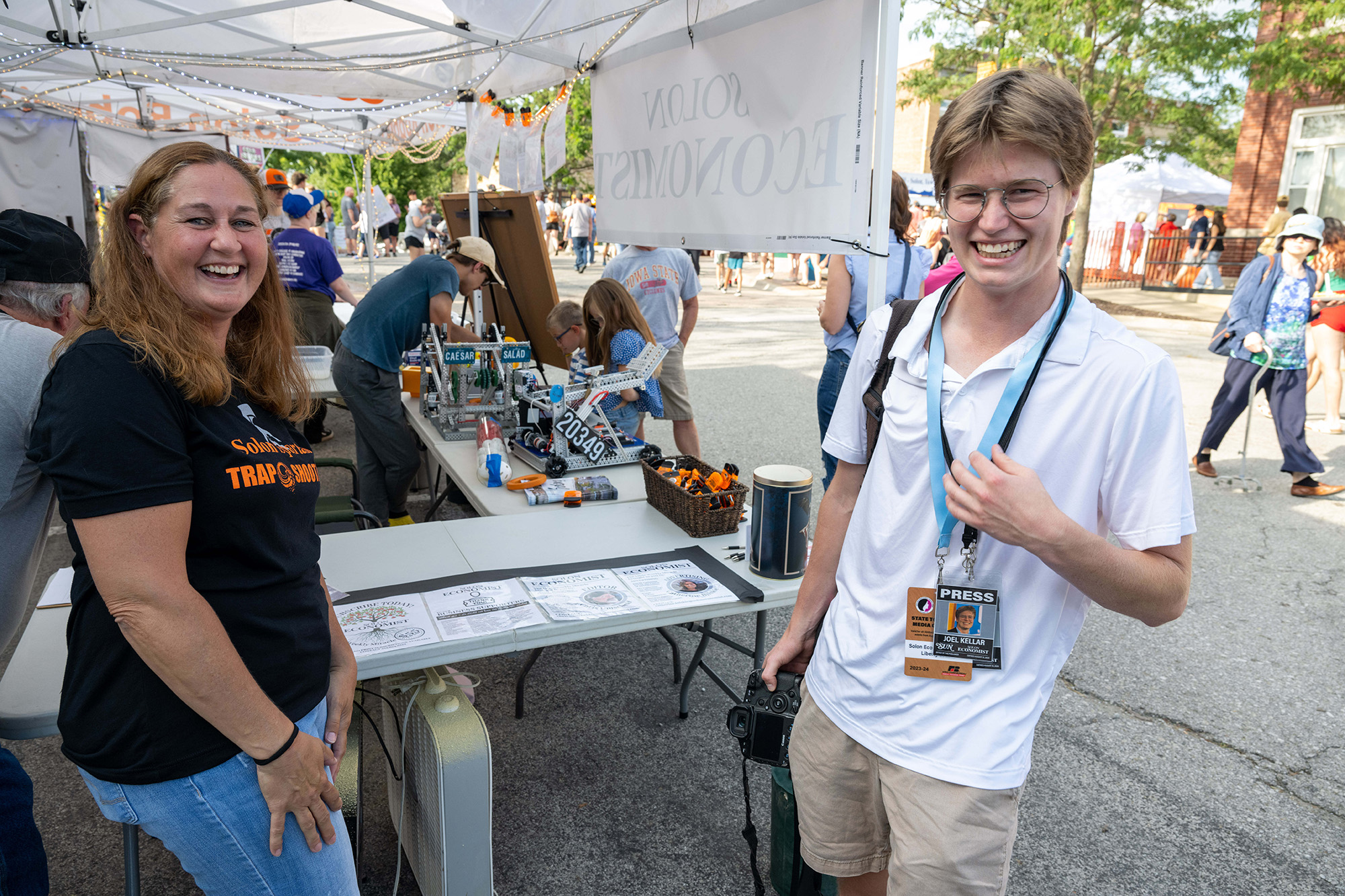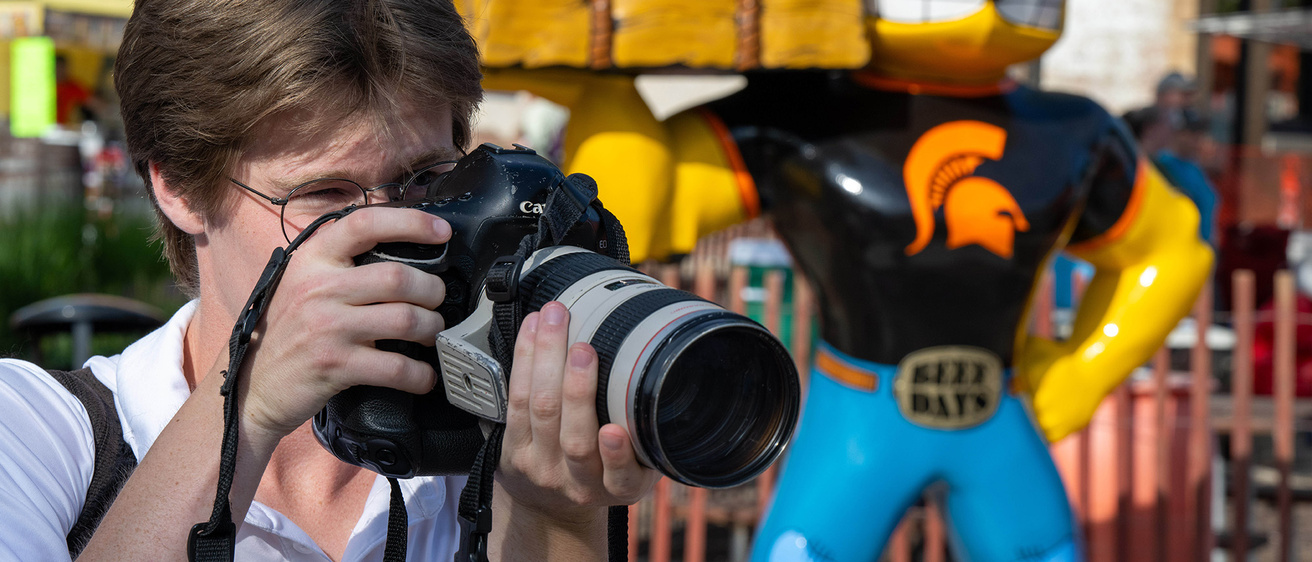In addition to helping two community newspapers stay afloat, the purchase of the Solon Economist and the Mount Vernon–Lisbon Sun by The Daily Iowan is giving University of Iowa students more on-the-job training — and a taste of journalism practices in a small town.
Story: Sara Epstein Moninger
Photography: Justin Torner
Published: Oct. 2, 2024
The top photo...
Joel Kellar, a University of Iowa student and Daily Iowan photographer, shoots photos for the Solon Economist during Solon Beef Days. Kellar worked over the summer as an intern for the Economist, one of two community newspapers acquired by The Daily Iowan.
Stunned. Surprised. Intrigued. Optimistic. Excited.
Reactions to the news that the University of Iowa’s independent, student-run newspaper, The Daily Iowan, was acquiring two community weeklies in early 2024 seemed to run the gamut. It may just be the only such news-academic partnership that exists.
What appealed to Jason Brummond, the newspaper’s publisher, and Melissa Tully, head of Iowa’s School of Journalism and Mass Communication, about the purchase of the Solon Economist and the Mount Vernon–Lisbon Sun was the opportunity to boost production capabilities at two eastern Iowa newspapers that were under constant threat of folding, while also adding to the school’s growing catalog of experiential learning opportunities.
“We were motivated by the preservation aspect — and thought that we could do a good job with it — but from a student perspective, it presented a new opportunity, one that we have not offered before,” says Brummond, a UI graduate who earned a BA and a BBA in 2008 and an MBA in 2014.
The plan for Iowa’s new partnership is for Daily Iowan staff to cover stories that the minimally staffed newspapers can’t take on, providing a freelance pool of sorts, and to repurpose original Daily Iowan content for those papers when relevant. It will also create internships for students to work directly with the papers’ editors to create content and allow journalism faculty to work with students in their classes to develop content specific to those news audiences.
The arrangement already has started paying off. Two undergraduate journalism students were selected as the first interns over the summer: Joel Kellar of Urbandale, Iowa, worked as a reporter, while Marandah Mangra-Dutcher of Johnston, Iowa, was a page designer. Brummond says plans include creating a business-related internship.
Mangra-Dutcher, who has been a design editor at The Daily Iowan, worked about 15 hours remotely each week for the internship, learning about everything from proofreading to ad design. When she graduates in May 2025, she hopes to secure a job in journalism, potentially working in data visualization for a print magazine or newspaper. She believes The Daily Iowan’s partnership with local newspapers will have an impact beyond campus.
A tradition of excellence
The University of Iowa has had a student-produced newspaper since 1868. Student staff members at The Daily Iowan have earned multiple honors and awards for their work throughout the years, placing the paper among the best in the country. The newspaper is an independent nonprofit organization that offers invaluable hands-on opportunities to all UI students. Now students can also get experience at two nearby community newspapers.

Marandah Mangra-Dutcher worked about 15 hours remotely each week for her internship with the community newspapers serving Solon, Mount Vernon, and Lisbon, learning about everything from proofreading to ad design.
“The acquisition of these two papers sets an example for other student newsrooms, or newsrooms in general, for what could happen if we invest more in local news and make sure that we still have these information networks set up across the United States,” she says.
Brummond and Tully already have received inquiries from other institutions interested in the model. Although the idea of a news-academic partnership is not a new one, Tully thinks this specific situation — involving an independent and nonprofit student-run paper — is a first. She also says it demonstrates the values of the UI School of Journalism and Mass Communication, which celebrated its 100th anniversary in 2024.
“Using our resources to support these papers is a reflection of our commitment to support high-quality local journalism, and these two communities are vibrant places that deserve coverage,” Tully says. “Students will get a chance to do community journalism and then take that perspective with them when they graduate. Maybe they’ll decide to pursue community reporting in western Iowa or northern Nebraska or wherever. We want to support the local news ecosystem by giving students an opportunity to dabble in it in a way that is structured and sustainable and by incorporating it across our curriculum.”
Kellar, who also serves as a television reporter for DITV and as a production assistant for the Big Ten Network, wants to pursue a job in sports writing and says the internship with the Solon Economist and the Mount Vernon–Lisbon Sun opened his eyes to working in a small town. He enjoyed getting to know the communities — and being embraced by the residents.

As an intern, Joel Kellar wrote about two stories a week for the “Mount Vernon–Lisbon Sun” and several more for the “Solon Economist.” He had the opportunity to cover Solon High School’s softball state tournament run, and visited community events such as Solon Beef Days (shown above) and Mount Vernon’s Heritage Days Festival.
Although he did do some sports reporting, including covering Solon High School’s softball state tournament run, Kellar says having a wide variety of assignments unrelated to sports, from community events such as Solon Beef Days and Mount Vernon’s Heritage Days Festival, to interviews with area businesspeople and the county sheriff, allowed him to sharpen his skills.
“It’s been really fun covering news, and I think it’s made me a much better reporter,” says Kellar, who wrote about two stories a week for the Mount Vernon–Lisbon Sun and several more for the Solon Economist. “I feel like I’m more well-rounded now and that I conduct better interviews.”
Chris Umscheid, editor of the Solon Economist, says having an intern is a win-win, calling Kellar a “godsend,” and he looks forward to working with more students. Unlike his peers at the Mount Vernon–Lisbon Sun, which has a small staff, Umscheid works alone.
“Having Joel as an intern was fantastic, even better than I expected. It took quite a bit off my plate,” he says. “But the big thing was seeing Joel’s enthusiasm, his energy level, and his passion.”
Tully says the hope is to build a long-term and sustainable engagement with these papers and their communities.
“We want the students to learn about these communities and for the communities to learn about the students. It’s relationship building,” she says. “Ideally, students will be able to work with these papers throughout their time at Iowa. Investing in opportunities like this is going to set our students up not only for their first job but also for a lifetime of success.”
Did you know?
Undergraduate students in the University of Iowa School of Journalism and Mass Communication, which turns 100 in 2024, can take advantage of multiple experiential learning opportunities, whether they are pursuing a degree in journalism and mass communication or in sport media and culture. In addition to creating content for an independent nonprofit newspaper, DITV television programming, and an FM radio station, students can take Community Engaged Courses, complete one or more internships, study abroad, and conduct research.
